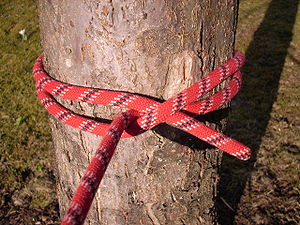- Clove hitch
-
Clove hitch Category Hitch Origin Ancient Related Slippery hitch, Two half-hitches, Buntline hitch, Cow hitch, Constrictor knot, Ground-line hitch, Lashings, Snuggle hitch Releasing Jamming Typical use Securing lines running along a series of posts, belaying, starting lashings, weak binding Caveat Can spill if the standing part is pulled forcibly in the wrong direction ABoK #11, #53, #69, #70, #204, #400, #421, #437, #1176, #1177, #1178, #1179, #1180, #1245, #1773, #1774, #1775, #1776, #1778, #1779, #1814, #2079, #2541, #2542, #2543, #2544, #2546, #2547, #2548 A clove hitch is a type of knot. Along with the bowline and the sheet bend, it is often considered one of the most essential knots.[1] A clove hitch is two successive half-hitches around an object. It is most effectively used as a crossing knot. It can be used as a binding knot, but is not particularly secure in that role.[2] A clove hitch made around the line itself is known as either two half-hitches or buntline hitch, depending on whether the half-hitches progress away from or towards the object.
Contents
Usage
This knot is particularly useful where the length of the running end needs to be adjustable, since feeding in rope from either direction will loosen the knot to be tightened at a new position. The clove hitch can slip when loaded. With smaller diameter cords, after being heavily weighted it may become difficult to untie. It is also unreliable when used on a square or rectangular post, rather than round.
Tying
To tie a clove hitch at the end of a rope as shown at right, pass the end around the pole starting at the right, with the end coming around below. Put the end around in the same direction to cross over the standing end to be above the first loop. As the end comes around, put it under itself to be over the standing end. To start on the left side, the end comes around over the standing end, crossing it by wrapping below, then comes around to go under itself below the standing end. Check that both ends are in the middle, emerging in opposite directions. Pull to tighten. When pulled tighter, the rope passing over itself binds it in place.
It can also be formed in the middle of a rope, if the end of the object is there. One way is to form two overhand loops in the rope. If both have the working end passing over the standing line, slide the second loop underneath the first one. If you made both loops with the working end under the standing line, slide the second loop over the first one. Drop both loops together onto the end of the object. Another way is to make a loop over the end of the object so that the working end is below. Twist the next loop with the working end again under, and slip it over the object. Before tightening, be sure that both ends are in the middle, emerging in opposite directions. This way of tying a clove hitch is used for instance at belay stations of multi-pitch climbs[3].
Other Uses
The clove hitch is commonly used in scouting to start and finish a lashing such as the square lashing, diagonal lashing, and sheer lashing.[4]
See also
References
- ^ Cassidy 1985, The Klutz Book of Knots
- ^ Clifford W. Ashley, The Ashley Book of Knots (New York: Doubleday, 1944), 224.
- ^ "Clove Hitch on a carabiner from left and right". www.climbignextreme.com. http://www.climbingextreme.com/2011/01/clove-hitch-on-a-carabiner-from-left-and-right/770. Retrieved 2011-01-17.
- ^ "Clove Hitch used in pioneering". www.pioneeringmasters.org. http://pioneeringmasters.org/PM_lashings.php. Retrieved 2011-04-01.
External links
- Grog's Animated Knots: How to tie the clove hitch
- Notable Knot Index - shows quick method of tying
- Hitch Knots - including instructions
Categories:- Hitch knots
Wikimedia Foundation. 2010.


